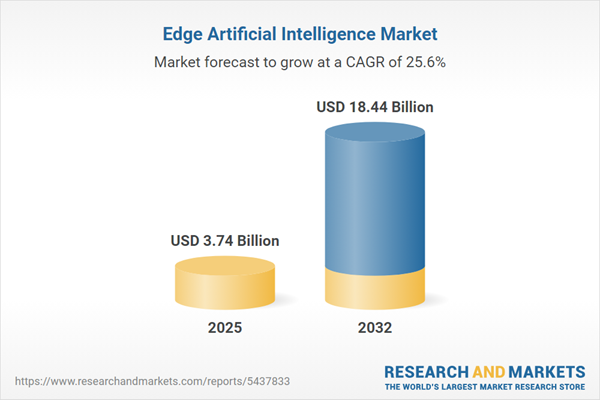Speak directly to the analyst to clarify any post sales queries you may have.
Edge artificial intelligence is rapidly reshaping enterprise operations, revolutionizing data processing and accelerating on-site decision-making for businesses across sectors. This report provides senior decision-makers with a comprehensive, actionable analysis of market size, growth drivers, emerging applications, and strategic imperatives for competitive advantage in the evolving landscape.
Market Snapshot: Edge Artificial Intelligence Market Size and Growth
The Edge Artificial Intelligence Market grew from USD 2.97 billion in 2024 to USD 3.74 billion in 2025. It is expected to continue growing at a CAGR of 25.61%, reaching USD 18.44 billion by 2032.
This sustained expansion reflects an industry-wide shift toward distributed data processing, enabling immediate insight delivery and operational agility at the network edge. Demand is being driven by sectors that require low-latency analytics, secure data management, and local compliance, positioning edge AI as a cornerstone for digital transformation and future-ready infrastructure.Scope & Segmentation
- Component Types: Accelerators, memory, processors, storage, managed services, professional services, application software, middleware, and platform software
- End-Use Industries: Commercial vehicles, passenger vehicles, smart home, smartphones, wearable devices, oil and gas monitoring, smart grid, medical imaging, patient monitoring, automotive manufacturing, electronics manufacturing, food and beverage production, in-store analytics, and online personalization
- Application Areas: Fraud detection, intrusion detection, facial recognition, object detection, visual inspection, speech recognition, text analysis, demand forecasting, and predictive maintenance
- Deployment Modes: Cloud-based, hybrid, on-device (microcontrollers, mobile devices, single board computers)
- Processor Types: ASIC, CPU (Arm and x86), DSP, FPGA, discrete GPU, integrated GPU
- Node Types: IoT devices, mobile devices, wearable devices, gateways, routers, base stations, distributed nodes
- Connectivity Types: Private 5G, public 5G, Ethernet, LPWAN, WiFi 5, WiFi 6
- AI Model Types: Convolutional neural networks, recurrent neural networks, transformer models, decision trees, support vector machines
- Regional Coverage: United States, Canada, Mexico, Brazil, Argentina, Chile, Colombia, Peru, United Kingdom, Germany, France, Russia, Italy, Spain, Netherlands, Sweden, Poland, Switzerland, United Arab Emirates, Saudi Arabia, Qatar, Turkey, Israel, South Africa, Nigeria, Egypt, Kenya, China, India, Japan, Australia, South Korea, Indonesia, Thailand, Malaysia, Singapore, Taiwan
- Leading Companies: NVIDIA Corporation, Intel Corporation, Qualcomm Incorporated, Advanced Micro Devices Inc., NXP Semiconductors N.V., Texas Instruments Incorporated, MediaTek Inc., Samsung Electronics Co. Ltd., Microchip Technology Incorporated, Lattice Semiconductor Corporation
Key Takeaways for Decision-Makers
- Enterprises are shifting data analytics from the cloud to the edge, enabling real-time decisions and improving operational efficiency in time-sensitive environments such as manufacturing and autonomous systems.
- Embedding AI processing within devices advances privacy and regulatory compliance, especially in industries managing sensitive or sovereign data.
- Specialized hardware and connectivity innovations, including dedicated AI chips and private 5G networks, are lowering barriers to sophisticated edge deployments across multiple sectors.
- Federated learning models and open modular software stacks help preserve data privacy while leveraging distributed data for robust, adaptive analytics.
- Strategic alliances between chipmakers, platform providers, and domain specialists are speeding up innovation and application-specific solution rollout.
- Regional adoption trends are shaped by distinct regulatory, infrastructure, and industry priorities; success depends on localized strategy and technology alignment.
Tariff Impact on Edge Artificial Intelligence Ecosystem
Recent United States tariff measures on semiconductors, hardware, and select software components have added cost pressures throughout the ecosystem. Manufacturers and service providers are diversifying supply chains, exploring domestic fabrication, and revising software strategies to offset higher procurement and licensing expenditures. These tariff-driven adjustments may influence total cost of ownership and the scalability of edge AI initiatives, with pronounced effects in automotive, healthcare, and sectors relying on specialized imports.
Methodology & Data Sources
Findings in this report are based on combined qualitative expert interviews and quantitative analysis. The research team integrated insights from technology executives, industry publications, regulatory documents, and data from device, software, and service providers. Analytical frameworks were applied to identify drivers, constraints, and trends, ensuring a robust and multidimensional market assessment.
Why This Report Matters
- Supports informed investment, development, and deployment strategies across diverse edge AI markets, accelerating time to value.
- Equips leadership teams with contextual, segment-specific intelligence for navigating regulatory complexity and aligning innovation with local market needs.
Conclusion
Edge artificial intelligence is redefining where and how intelligence is applied in enterprise operations. Leaders who act on segment-specific insights and adapt strategies for regulatory and technological shifts are poised to unlock exceptional value and sustained growth.
Additional Product Information:
- Purchase of this report includes 1 year online access with quarterly updates.
- This report can be updated on request. Please contact our Customer Experience team using the Ask a Question widget on our website.
Table of Contents
3. Executive Summary
4. Market Overview
7. Cumulative Impact of Artificial Intelligence 2025
List of Figures
Samples

LOADING...
Companies Mentioned
The key companies profiled in this Edge Artificial Intelligence market report include:- NVIDIA Corporation
- Intel Corporation
- Qualcomm Incorporated
- Advanced Micro Devices, Inc.
- NXP Semiconductors N.V.
- Texas Instruments Incorporated
- MediaTek Inc.
- Samsung Electronics Co., Ltd.
- Microchip Technology Incorporated
- Lattice Semiconductor Corporation
Table Information
| Report Attribute | Details |
|---|---|
| No. of Pages | 199 |
| Published | October 2025 |
| Forecast Period | 2025 - 2032 |
| Estimated Market Value ( USD | $ 3.74 Billion |
| Forecasted Market Value ( USD | $ 18.44 Billion |
| Compound Annual Growth Rate | 25.6% |
| Regions Covered | Global |
| No. of Companies Mentioned | 11 |









